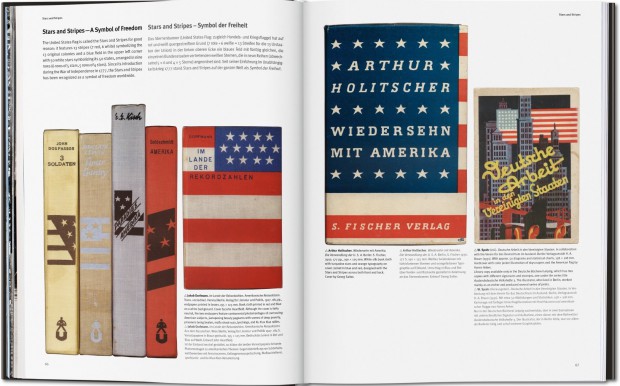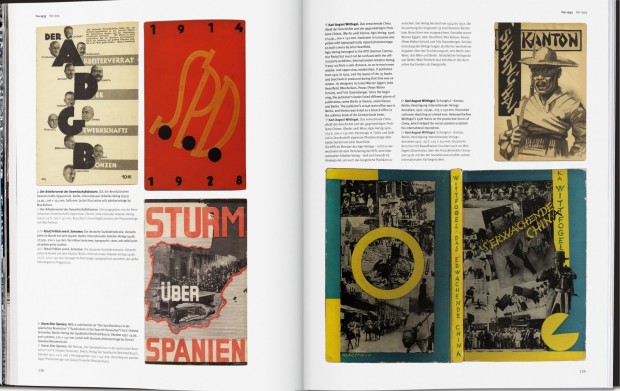Berlin between the wars was a prospering and innovative capital unlike any other in the world. In 1927 alone Berlin was home to 929 publishing houses and put out a fourth of Germany’s entire book production. Book printing was also promoted by the many local newspapers and their respective hardware; to tap the full potential of their printing presses, newspaper publishers soon also printed books and journals, became publishing houses or took over book publishers.
 After WWI fresh ideas and brand-new possibilities to experiment, draw and invent new designs appeared on the scene and left their marks on contemporary book arts too, by combining traditional drawings with photomontage, new and oversized fonts.
After WWI fresh ideas and brand-new possibilities to experiment, draw and invent new designs appeared on the scene and left their marks on contemporary book arts too, by combining traditional drawings with photomontage, new and oversized fonts.
Those illustrators and cover artists could experiment freely, possibly only because the small publishers had no marketing supervisors who may have not allowed experimental covers and because some publishers wanted to communicate their very own uniqueness and modernity.
The book arts, usually referring to text, styling, typography, binding, endpapers and other properties of book production, here in The Book Cover in the Weimar Republic will be reduced to the binding and dust jacket. The first German books with a dust jacket appeared around 1895.
However, adding a paper cover to the book made production of the entire product much cheaper, since books then no longer called for expensive cloth binding. Using a paper (and sometimes cardboard) cover also helped advertise the book in shops, while on the flip side additional promotional texts would be displayed and, following an American habit, on the cover inside short media reviews of the author and the book at hand would be placed.  Unfortunately, the paper covers were never appreciated much by the consumers, who more often than not threw those away immediately, when the cover became torn or showed signs of use.
Unfortunately, the paper covers were never appreciated much by the consumers, who more often than not threw those away immediately, when the cover became torn or showed signs of use.
Several chapters in Holstein’s book, dived by theme, style or genre, deal with the work of illustrators and cover designers. That is, as far as their names were preserved; often though, publishing houses simply left out the artist’s names and the works of hundreds if not thousands of designers are impossibly to identify today.
Holstein presents 1.000 of those beautiful pieces of art from his personal collection, often mirroring Dada, Expressionism, the Bauhaus, Surrealism and early photomontage. Looking at those covers makes contemporary book titles look somewhat dull. The selection is reduced to books published in Berlin.
 So be prepared for many, many incredible covers, some of which could easily make tall posters or fill galleries. The index lists those artists that could be identified as the designers and there we find famous names like Frans Masereel, John Hartfield, Georg Salter, Herbert Bayer, Will Faber, Karl Gossow, Georg Grosz, Dugo, and Olaf Gulbansson.
So be prepared for many, many incredible covers, some of which could easily make tall posters or fill galleries. The index lists those artists that could be identified as the designers and there we find famous names like Frans Masereel, John Hartfield, Georg Salter, Herbert Bayer, Will Faber, Karl Gossow, Georg Grosz, Dugo, and Olaf Gulbansson.
Book collectors specialized in German literature will be pleased by the several long essays on publishers like Die Schmiede, Adalbert Schultz, Delta Verlag, Neuer Deutscher Verlag, Malik Verlag, Der Bücherkreis, Arbeiterjugend-Verlag, Paul Cassierer, Elena Gottschalk and others. Some publishers starting back then, like Ullstein, Rowohlt and Fischer Verlag, are still in operation today, while the majority of the publishing houses did not survive the Nazi terror when either their program was considered improper for political or esthetic reasons, their founders were deported to the concentration camps because of Jewish descent or because the company was simply dispossessed by the fascist government.
Other very beautiful sections here are the cover collection of Erich Kaestner’s books for children, many cover samples of Upton Sinclair’s books, and Peter Nils Dorén’s essay on typography and lettering.
The huge book (with text in English and German) is edited by Jürgen Holstein, publisher, collector and antiquarian bookseller from Berlin. Together with his wife Waltraud Holstein he has published 100+ catalogs in various fields of art history. He has also published numerous titles on book design.
Review by Dr. A. Ebert © 2015
Jürgen Holstein (ed.) The Book Cover in the Weimar Republic. Taschen, 2015, 452 p., ISBN 978-3-8365-4980-6.
